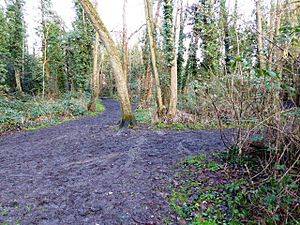Alder Moors facts for kids
Quick facts for kids Alder Moors |
|
|---|---|
 |
|
| Type | Local Nature Reserve |
| Location | Woodley, Berkshire |
| OS grid | SU 775 739 |
| Area | 8.5 hectares (21 acres) |
| Managed by | Wokingham District Council |
Alder Moors is a special natural area in Woodley, Berkshire. It's a Local Nature Reserve, which means it's protected for its wildlife and plants. This lovely spot is about 8.5 hectares (or 21 acres) big. That's like 21 football fields! The local council, Wokingham District Council, looks after it.
The name 'Aldermoors' comes from the many alder trees that grow here. It's an ancient woodland, meaning it has been a forest for a very long time. Some parts of the wood are also coppiced, which is a way of cutting trees to help them grow back stronger.
Contents
History of Alder Moors
In 1990, Alder Moors was officially made a Local Nature Reserve. This was done by Wokingham Borough Council. It helps make sure this important natural space is kept safe for everyone to enjoy.
Animals at Alder Moors
Alder Moors is home to many different animals. You might spot some of these if you visit!
Mammals
Invertebrates
- Green-veined white (a type of butterfly)
- Holly blue (another butterfly)
- Peacock butterfly
- Comma butterfly
- Speckled wood (a butterfly with speckled wings)
- Hornet moth
- Kidney Spot ladybird
- Stigmella aurella (a tiny moth)
- Holly leaf miner (a small insect that lives in holly leaves)
Birds
- Mallard (a common duck)
- Canada goose
- Red kite (a large bird of prey)
- Eurasian sparrowhawk (a fast hunter)
- Common buzzard (another bird of prey)
- Common chiffchaff (a small songbird)
- Eurasian blackcap (a bird with a black 'cap')
- Eurasian wren (a tiny, busy bird)
- Greylag goose
- Grey Heron (a tall, wading bird)
- Eurasian treecreeper (a bird that climbs tree trunks)
- Mute swan
- Common chaffinch (a colourful finch)
- Coot (a water bird)
Amphibians & Reptiles
Plants at Alder Moors
This nature reserve has a wide variety of plants, from tall trees to small flowers.
Trees
- Field maple
- Sycamore
- Common alder
- Common hazel
- Hawthorn
- European ash
- Holly
- Wild cherry
- Cherry plum
- Blackthorn
- Pedunculate oak
- Elder
- Yew
- English elm
Other Plants
- Moschatel (also called Town Hall Clock)
- Garlic mustard
- Wood anemone
- Wild angelica
- Upright hedge-parsley
- Cow parsley
- Lesser burdock
- Cuckoo pint (also called Lords and Ladies)
- Hart's-tongue fern
- Common daisy
- Wood false brome
- White bryony
- Marsh marigold
- Wavy bittercress
- Pendulous sedge
- Greater celandine
- Opposite-leaved golden-saxifrage
- Creeping thistle
- Spear thistle
- Cock's-foot (a type of grass)
- Crested wood fern
- Petty spurge
- Lesser celandine
- Meadowsweet
- Cleavers
- Shining cranesbill
- Herb-Robert
- Wood avens
- Ground-ivy
- Hogweed
- Yorkshire fog (a type of grass)
- Bluebell
- Tutsan
- Himalayan balsam
- Yellow iris
- Soft rush
- Hard rush
- Yellow archangel
- White dead-nettle
- Red dead-nettle
- Perennial ryegrass
- Honeysuckle
- Honesty
- Hairy wood-rush
- Creeping Jenny
- Yellow pimpernel
- Water mint
- Dog's mercury
- Wood forget-me-not
- Hemlock water-dropwort
- Wood sorrel
- Evergreen bugloss
- Greater plantain
- Annual meadow grass
- Common polypody
- Soft shield fern
- Common primrose
- Bracken
- Creeping buttercup
- Redcurrant
- Bramble
- Broad-leaved dock
- Water figwort
- Greater stitchwort
- Common chickweed
- Dandelion
- Gorse
- Common nettle
- Ivy-leaved speedwell
- Wood speedwell
- Persian speedwell
- Sweet violet
- Early dog-violet
- Common dog-violet
Images for kids


